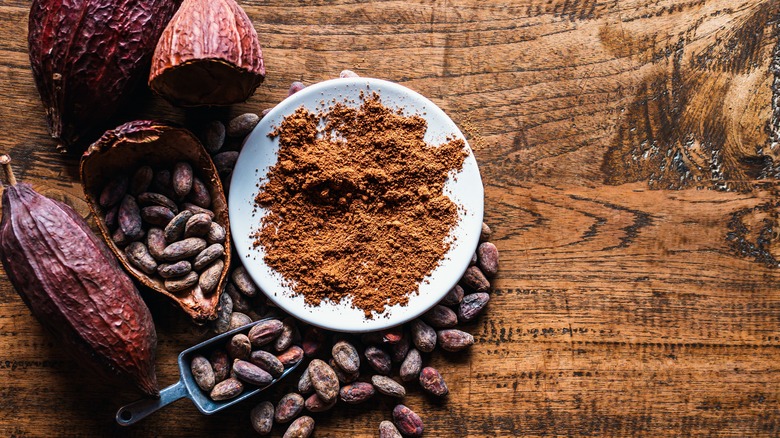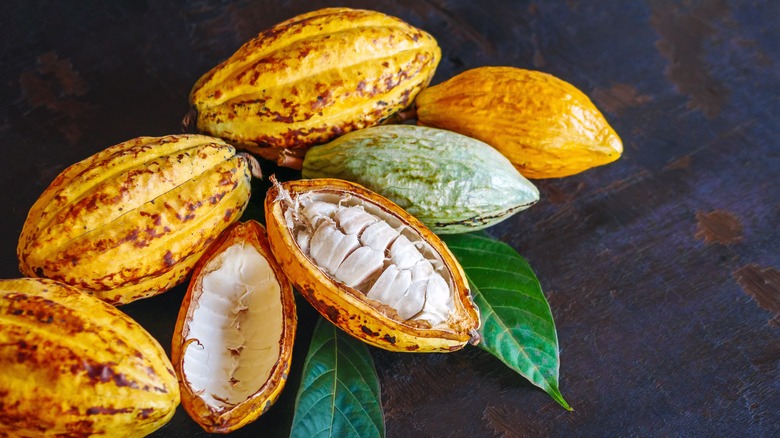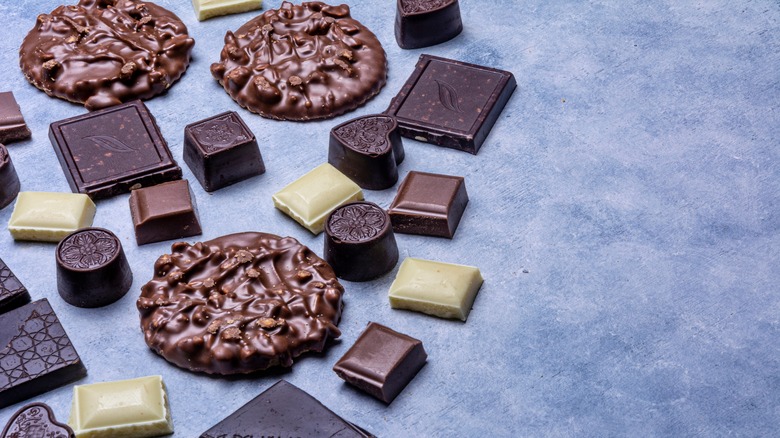Who Invented Chocolate And How Was It Made Then Vs. Now?
Whether you enjoy the occasional square of dark chocolate or have a candy bar with your morning coffee every day, it is hard to deny that chocolate has become a huge part of modern society. What began as a prized, bitter liquid that was used in a ceremonial fashion more than 5,000 years ago has transformed over the centuries into a sweet, smooth treat that adorns store shelves worldwide.
Today, chocolate is everywhere: From hot chocolate to rich truffles, we all have our favorite way to eat or drink it. But chocolate has changed dramatically since its beginnings in South America, and scientific inventions along the way have played a critical role in shaping it into the modern delicacy we know and love today. Take a look at the science and history behind the journey of chocolate over the years, from who discovered it, to how it compares to the candy we eat today.
Ancient origins of chocolate — South America
Until very recently, it was widely believed that the origins of cacao — the plant from which chocolate is made — dated back to Mexico around 4,000 years ago. However, research in recent years has suggested that it actually dates back much further than that and originated in South America.
This new theory was sparked by archaeologist Professor Michael Blake, as he investigated a site in modern day Ecuador. After discovering a substance that he suspected may be cacao on some pottery, it was analyzed and found to contain traces of theobromine, which strongly suggested the presence of cacao beans. They were also able to identify DNA that confirmed a connection to modern cacao. The pottery in question was dated as far back as 3300 B.C., making it the oldest evidence of chocolate being used.
The way in which the cacao was discovered suggests that the Mayo-Chinchipe people of the region were using it to make a beverage — perhaps the first ever hot chocolate. While we now like to enjoy this treat on a cold winter's evening, there is a good chance that it was used in a ceremonial fashion. This discovery adds another enticing layer to the story of chocolate, and it proves that this special bean has been revered for much longer than previously imagined. The journey from upper Amazon to Hershey's is a long and complex one, but it is encouraging to know that these ancient civilisations were as obsessed with chocolate as we are.
Early chocolate use in Mexico
Before the revelations in the 2010s confirming South America as the home of cacao, it was widely accepted that it originated in Mexico somewhere around 1500 to 2000 B.C. Early Mexican civilizations including Mayans and Aztecs cherished chocolate, with the Mayans even equipping their dead with it to guide them in the afterlife. The Aztecs traded with cacao instead of gold at times, and they are thought to have introduced it to the Spanish.
Both the Mayans and Aztecs fermented their cacao beans in the sun, which intensified the chocolate flavor we are familiar with and reduced some of the bitterness. They were sometimes toasted, too, to create a smokiness. The Mayans enjoyed their chocolate drinks hot, whereas their Aztec counterparts likely preferred to serve it cold. The Aztecs were so skilled in their cacao beverage making that they even created a chocolate precursor to the cappuccino. By transferring the drink backward and forward from one receptacle to another, it created an airy foam, similar to the modern one we all know and love.
It is safe to say that while they may not have been the first to discover it, ancient Mexican civilizations were certainly responsible for popularizing chocolate and contributing to the way we use it now. Were it not for them, we may not have the billion-dollar chocolate industry that we now have.
Cocoa vs cacao
If you are a fan of chocolate, you may have noticed that sometimes the word cocoa is on the ingredients list, and on other products it may say cacao. It is not a misspelling, but in fact, the two words refer to different aspects of the same plant. However, there can be confusion, since there is some inconsistency on the use of the term cacao. From a science perspective, everything chocolate comes from the cacao bean, which is the seed of the cacao tree (theobroma cacao.) These beans are then fermented and dried, but the next step depends on whether the desired product is raw cacao or cocoa.
To create raw cacao powder, the beans are cold-pressed, separating the cacao butter from the cacao powder. This powder has not been affected by heat — other than the sun during the drying process — and as a result retains the majority of its beneficial compounds, including powerful antioxidants. For the majority of commercial chocolate, the beans will be roasted instead, creating cocoa. This is a cooked product, which changes the chemistry of the food, particularly affecting the antioxidant content. While high-percentage cocoa products still have significant health benefits, especially when compared to high-sugar candy, they are not as potent as the raw form of cacao.
Confusingly, chocolate makers don't use the same terminology, and they consider everything that has been removed from the bean to be cocoa, rather than cacao. For the purpose of choosing a healthy product, you can consider raw cacao to be the least processed form of chocolate, and therefore the most beneficial.
How did sweetened chocolate emerge?
When the ancient Mayans and Aztecs drank their cacao drinks almost 4,000 years ago, they didn't have access to the varieties of sugars that we now have available. Their chocolate drinks would likely have been extremely bitter, occasionally contrasted by the addition of chilis. By the time it reached mainland Europe, in 16th-century Spain, sugar cane was in use, and the Spaniards adapted the flavor to their tastes by forgoing the chilis and adding in cinnamon and sugar.
Surprisingly, solid chocolate didn't exist at all until the late 1820s, when Dutch cocoa maker Casparus van Houten separated out the powder using his cocoa press. Later in the century, John Cadbury, Henry Rowntree, and Joseph Fry would individually progress the industry further, with Fry releasing the first recognizable chocolate bar in 1847, and all three improving on it in the coming years.
Swiss chocolatier Daniel Peter first had the idea of adding milk to chocolate to mellow out its flavor, before forming the Nestlé Company with Henri Nestlé. Contemporary, smooth milk chocolate as we know it was then produced a few years later by Rodolphe Lindt, and the modern chocolate industry was born.
Turning cacao into chocolate
Even as an avid chocolate lover, if you were to open up a fresh cacao pod, the chances are you wouldn't recognize the smell, or even the flavor. The cacao beans have a white pulp surrounding them that's said to have a floral, fruity flavor that is far removed from what we consider to be the taste of chocolate. So how do we get from fresh cacao pods to the chocolate on our shelves?
Fermentation is the first step, where the characteristic chocolate taste that we love begins to develop. The cacao can reach temperatures of 120 degrees Fahrenheit or higher during this process, but the chocolate made from these beans would still be considered raw. Drying comes next to ensure the chance of harmful microbes developing is reduced, before the beans are transferred to the chocolate makers.
The top-grade beans will then be roasted, which takes place at a moderate heat, to prevent the cocoa from burning. For an artisan chocolate maker, the roasting of the beans is crucial in determining the quality of the final chocolate. The shells of the beans are then cracked open to reveal the delicious chocolate inside, before grinding it down to create chocolate liquor. After refining, the last step in the process is tempering the chocolate, and if you watch a lot of cookery competitions, you will know how difficult this step can be! To truly understand this crucial technique, you'd need to take a look at the chemistry behind it.
The science of tempering chocolate
On the face of it, tempering chocolate seems relatively straightforward — heat it gently until it melts, cool it back down, then warm it a little again. Why then, does it cause so much heartache on every season of "MasterChef"? It all comes down to the types of crystals that are formed when chocolate is heated to certain temperatures, and the efforts to control that outcome.
The cocoa butter in chocolate can form at least six different crystal structures, depending on the temperature it is heated to, and the properties of the chocolate will depend on the dominant crystals that form. To create the ultimate chocolate — smooth, lustrous, and with just the right texture to give a perfect crack when it breaks — you need to encourage the crystal known as Type V to form in larger quantities than the others. The reason for the repeated heating and cooling is to allow Type V to form by cooling it slowly, then heating it back up to exactly the correct temperature to melt four of the less desirable forms. This results in the majority of crystals being Type V once the chocolate is cooled for the final time.
The precision temperatures are what makes tempering so tricky, as a couple of degrees either way can scupper your attempts. If you want to attempt chocolate tempering at home, a good chocolate thermometer will make the process much easier.
Nutritional profile of chocolate (cacao)
When it comes to eating a nutrient-rich diet, chocolate — that's real chocolate, not candy — is a food that needs to be added to your shopping list. If it has always been your dream to have someone tell you that you needed to eat chocolate for the good of your health, you are in luck.
Cacao is incredibly nutrient-dense and is packed with minerals. It contains more magnesium than virtually any other plant, making it important for mood and brain health. Magnesium can help you get a good night's sleep, too, so nibbling on some dark chocolate before bed may not be the worst idea after all. Cacao also contains many antioxidants, including flavonoids, which are powerful compounds that benefit cardiovascular health, balance blood sugars, and can even protect against cancer. Adding just a little cacao powder to smoothies or desserts can give your daily nutrition a much needed boost. Theobromine is another potent substance found in cacao, which is also present in smaller amounts in green tea. It is a stimulant that will give you a temporary boost and may help you to concentrate. As an anti-inflammatory compound, it will have positive effects on your health and help prevent chronic disease.
If you enjoy eating very dark chocolate, in the region of 80% to 90% cocoa, you should try incorporating raw cacao into your diet. It has the same bitter but satisfying flavor as the more popular dark chocolate, and the health benefits are substantial. Cacao is used in many health products, including raw chocolate, and can be snacked on as cacao nibs. If the bitter taste is a little too much, try adding it to a sweet smoothie, to give you an antioxidant boost with a more balanced flavor.
How the invention of the cocoa press changed the production of chocolate
One of the most significant inventions relating to chocolate came in 1828, when Dutch scientist Casparus Van Houten invented the cocoa press. His invention allowed cocoa butter to be separated from the cocoa powder at speed for the first time, leaving behind the dry cocoa powder we are now familiar with.
Prior to Van Houten's invention, separating the cocoa butter from the powder usually involved suspending the beans in bags for weeks at a time, until some of the cocoa butter dripped out. This was neither efficient nor effective, so Van Houten's press being able to separate the two elements out so quickly was a revelation. His invention was based on the hydraulic press that was invented by Englishman Joseph Bramah 30 years earlier. Once the Dutchman figured out how to use the process to apply pressure to cocoa beans, chocolate could then be made much more quickly and cheaply.
Van Houten's son Conrad continued his father's work in progressing the chocolate industry by working out a process now known as "Dutching." This involves washing the cocoa powder with an alkaline solution such as potassium carbonate to raise its pH, which has the double advantage of making it more soluble and less bitter. Between them, two generations of Van Houtens in the first half of the 19th century transformed the production of cocoa, and they got us on track to the industry we now have. The luxury chocolate bars and drinks you enjoy now owe a great deal to the Dutch pair.
Difference between dark, milk, and white chocolate
In our modern age of chocolate abundance, the only thing we need to worry about is choosing which type of chocolate to buy. While we all have favorite brands and varieties of flavors, chocolate is divided into three main categories. Dark chocolate is the "purest" form of modern chocolate, containing the highest percentage of cocoa compared to the others. You can buy 100% chocolate, either as raw cacao or roasted cocoa, but it does have a very bitter taste that some people consider too strong. However, for those who enjoy it, it is a chance to reap the many benefits of chocolate without the sugar, though some dark chocolate bars can have a cocoa percentage as low as 50%.
Milk chocolate, as the name suggests, has milk added to the cocoa, along with extra cocoa butter. This is the most popular type of chocolate in the U.S., with nearly half of Americans naming it as their preferred option. Milk chocolate is the type that finds its way into the majority of candy, due to its lack of bitterness and ease of consumption. There have been claims in recent decades that the addition of milk can have a negative effect on the antioxidant power of cocoa, reducing its effectiveness by as much as 30%, but other studies have shown conflicting results.
If white chocolate is your treat of choice, the bad news is that its pale color comes from a complete absence of cocoa. This means it has none of the antioxidant benefits of the darker chocolates, and should be eaten purely for pleasure, as it has little to offer in the way of nutrition.
Chocolate in the modern age
The modern chocolate industry is worth more than 100 billion dollars a year worldwide, and it's showing no signs of slowing down. What used to be a rare luxury is now a staple part of the average person's diet, either as an indulgent snack, or in its purest form, as a health food.
With the science of chocolate understood better now than ever, there are even new types of chocolate trying to break onto the scene, to steal the crowns of the original three. Blonde chocolate was invented by accident when a chef left it in a bain-marie, causing it to undergo the Maillard reaction and transform into a caramel-flavored delight. Ruby chocolate, on the other hand, was a more intentional invention, and it involves lightly fermented cacao beans that are reacted with citric acid to create a vivid, naturally pink color and a flavor that is more fruit like than the other types.
While these new chocolate types are having trouble being legally defined as unique varieties of chocolate,they are proof that the chocolate industry in the 21st century is continuing to move forward, which can only be a good thing for our taste buds.










